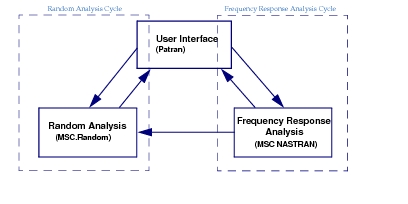XXXXXXXXXXXXXXXXXXXXXXXXXXXXXXXXXXXXXXXXXXXXXXXXXXXXXXXXXXXXXXXXXXXXXXXXXXXXXXXXXXXXXXXXXXXXXXXXXXXXXXXXXXXXXXXXXXXXXXXXXXXXXXXXXXXXXXXXXXXXXXXXXXXXXXXX''"> 11.3 Random Analysis Process
Process Overview
All random analysis runs will start with a frequency response run. The quality of this run will directly affect the random analysis results. Because of this relation, the term “random analysis” is often implied to mean the combined frequency response and random solutions. To eliminate potential confusion, the term “random analysis process” will be used when referring to the combined frequency response and random solutions. The “random analysis cycle” will be used when referring to just the random calculations and “frequency response analysis cycle” will be used when referring to just frequency response analysis iterations. These definitions are illustrated in
Figure 11‑4.
Figure 11‑4 Random Analysis Process
The frequency response and random analysis cycles will be discusses separately in following sections, but they will be presented in the order that the random analysis process would typically proceed.
Frequency Response Analysis Cycle
To streamline the process of creating a run ready MSC Nastran frequency response model, use the Frequency Response option in the MSC Random interface. See Frequency Response Analysis Setup section for detailed information.
Before the frequency response analysis is performed, it is important that the FEM has been evaluated for quality. Some basic guidelines are discussed below for ensuring that the FEM model is verified and ready for this step.
1. 1. In addition to the obvious finite element quality checks, also perform rigid body check (or ground check) using GROUNCHECK (see MSC Nastran Quick Reference Guide, Case Control Section).
2. Make sure the FEM refinement is adequate to capture all important modes throughout the frequency range of interest. Verify this by running a modal analysis and evaluating the mode shapes of key modes. This run should be made with identical boundary conditions the frequency response run will use.
3. After you have performed the frequency response analysis, make sure the natural frequencies match your modal analysis run.
Verifying the FEM is only one step in generating a quality frequency response analysis that is ready for random analysis. The input loads, damping and number and spacing of output frequencies also have to be verified. This is done by reviewing frequency response results. Response XYplots can be made to verify there are enough output points to capture the response profile. The XY plot in
Figure 11‑5 shows the responses from two different frequency response analyses of the same model. The curve with fewer points predicted RMS results 23% higher than the curve with more points. This would have been much worse if any important natural frequencies were skipped. Assuming at least all of the natural frequencies are recovered, the random RMS results will usually error on the high side when inadequate numbers of output frequencies are requested.
Figure 11‑5 Response Profile Comparison
The iterative process of verifying the FEM and verifying the frequency response analysis cycle is illustrated in
Figure 11‑6.
Figure 11‑6 Frequency Response Analysis Cycle.
Frequency Response Analysis Setup
Setting up MSC Nastran Frequency Response Analysis is an important part of random analysis process since random analysis, as explained in Section 2.0, is nothing but post processing of frequency response results. The Frequency Response Analysis setup can also be done using Patran, however, it is also included in MSC Random interface for ease of use for few simple loading cases (see Appendix A).
The interface in MSC Random is suited for following loading types.
1. Base Input Analysis: For Random PSD (Power Spectral Density) input is base excitation (G2/Hz)
2. Acoustic(Pressure) Input: For acoustic pressure input (pressure2/Hz).
3. Force Input: For PSD input of type (Force2/Hz or Moment2/Hz).
Random Analysis Cycle
The random analysis may be an iterative process, involving changes to the random input levels and other random parameters. This may be required as part of the model debugging process or simply due to different input requirements. This section is titled Random Analysis Cycle to emphasize this fact. Some changes, such as damping, analysis frequencies, output requests and model properties will require re-running the frequency response analysis and therefore feed back into the frequency response cycle, see Frequency Response Analysis Cycle.
Figure 11‑7 Random Analysis Cycle




